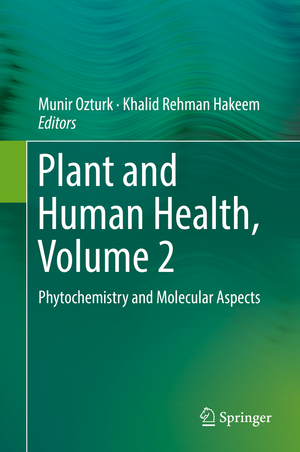Plant and Human Health, Volume 2: Phytochemistry and Molecular Aspects
Editat de Munir Ozturk, Khalid Rehman Hakeemen Limba Engleză Hardback – 31 ian 2019
Preț: 1218.07 lei
Preț vechi: 1485.46 lei
-18% Nou
Puncte Express: 1827
Preț estimativ în valută:
233.19€ • 242.39$ • 193.34£
233.19€ • 242.39$ • 193.34£
Carte tipărită la comandă
Livrare economică 05-19 februarie 25
Preluare comenzi: 021 569.72.76
Specificații
ISBN-13: 9783030033439
ISBN-10: 3030033430
Pagini: 722
Ilustrații: XXVI, 697 p. 155 illus., 61 illus. in color.
Dimensiuni: 155 x 235 mm
Greutate: 1.18 kg
Ediția:1st ed. 2019
Editura: Springer International Publishing
Colecția Springer
Locul publicării:Cham, Switzerland
ISBN-10: 3030033430
Pagini: 722
Ilustrații: XXVI, 697 p. 155 illus., 61 illus. in color.
Dimensiuni: 155 x 235 mm
Greutate: 1.18 kg
Ediția:1st ed. 2019
Editura: Springer International Publishing
Colecția Springer
Locul publicării:Cham, Switzerland
Cuprins
Foreword by Prof. Atta-ur-Rahman, UNESCO Science Laureate.- Antiepiletic Natural Products from Plants.- Plant-Derived Products and Health Care-Moroccon Story.- Pharmacological aspects of Phytodiversity from Bulgaria.- Resveratrol oligomers in Dipterocarpaceae.- Immunomodulating Activity of the Camel Prickle Water Extract.- Idiosyncratic toxicity of herbal product.- Recent advances in semi-mangrove natural products: source, chemistry, and bioactivities.- Medicinal plants of Malaysia: Phytochemistry and Molecular Biology.- Secondary Metabolism and Therapeutic Efficacy of Medicinal and Aromatic Plants.- New Compounds from Medicinal Plants of Bangladesh.- Xanthones from Medicinal Plants.- Flavonoids from Plants in Asia-Pacific.- Peroxygenases and Mushrooms.- New Flavanols, Saponins and Alkaloids from Vietnamese Plants.- Chemical and Biological, Anticancer, Antioxidant Activities of Vietnamese Plants.- Bioactlve Components from Different Plants in Rwanda.- Chemoprofiling-Bioefficacy of Herbal Drugs-Need for Standardization.- Lowering of Cholesterol Levels by Black Seed and Garlic.- Role of Biotechnology in the Medicinal and Aromatic Plants.- Innovation in Drug Discovery, Delivery and Pharmacy Practice.- Past, Present and Future Developments in Nutraceuticals.
Notă biografică
Dr. Khalid Rehman Hakeem (PhD) is an Associate Professor at King Abdulaziz University, Jeddah, Saudi Arabia. He has completed his Ph.D. (Botany) from Jamia Hamdard, New Delhi, India in 2011. Dr. Hakeem has worked as Post Doctorate Fellow in 2012 and Fellow Researcher (Associate Prof.) from 2013-2016 at Universiti Putra Malaysia, Selangor, Malaysia. His speciality is in Plant Eco-Physiology, Molecular biology, Plant-Microbe-soil interactions, Medicinal plant research and Environmental Sciences and so far has edited and authored more than 25 books with Springer International, Academic Press (Elsevier) etc. He has also to his credit more than 110 research publications in peer reviewed international journals, including 40 book chapters in edited volumes with international publishers. Dr Hakeem is the recipient of many national and international awards and fellowships.
Prof. (Dr.) Münir Öztürk (PhD) has served at the Ege University Izmir, Turkey for50 years in different positions. He has been elected as the “Vice President of the Islamic World Academy of Sciences”; has received the fellowships from Alexander von Humboldt, Japanese Society for Promotion of Science and National Science Foundation of USA. Dr. Ozturk has served as Chairman Botany Department and Founding Director Centre for Environmental Sudies, Ege University, Izmir, Turkey, as Consultant Fellow, Faculty of Forestry, Universiti Putra Malaysia, Malaysia and as Distinguished Visiting Scientist, ICCBS, Karachi University, Pakistan. His fields of scientific interest are Plant Eco-Physiology; Conservation of Plant Diversity; Biosaline Agriculture and Crops; Pollution, Biomonitoring, Medicinal and Aromatic Plants. He has published 40 books, 50 book chapters and 175 papers in journal with impact factor.
Textul de pe ultima copertă
Early anthropological evidence for plant use as medicine is 60,000 years old as reported from the Neanderthal grave in Iraq. The importance of plants as medicine is further supported by archeological evidence from Asia and the Middle East. Today, around 1.4 billion people in South Asia alone have no access to modern health care, and rely instead on traditional medicine to alleviate various symptoms. On a global basis, approximately 50 to 80 thousand plant species are used either natively or as pharmaceutical derivatives for life-threatening conditions that include diabetes, hypertension and cancers. As the demand for plant-based medicine rises, there is an unmet need to investigate the quality, safety and efficacy of these herbals by the “scientific methods”. Current research on drug discovery from medicinal plants involves a multifaceted approach combining botanical, phytochemical, analytical, and molecular techniques. For instance, high throughput robotic screens have been developed by industry; it is now possible to carry out 50,000 tests per day in the search for compounds which act on a key enzyme or a subset of receptors. This and other bioassays thus offer hope that one may eventually identify compounds for treating a variety of diseases or conditions. However, drug development from natural products is not without its problems. Frequent challenges encountered include the procurement of raw materials, the selection and implementation of appropriate high-throughput bioassays, and the scaling-up of preparative procedures.
Research scientists should therefore arm themselves with the right tools and knowledge in order to harness the vast potentials of plant-based therapeutics. The main objective of Plant and Human Health is to serve as a comprehensive guide for this endeavor. Volume 1 highlights how humans from specific areas or cultures use indigenous plants. Despite technological developments, herbal drugs still occupy a preferential place in a majority of the population in the third world and have slowly taken roots as alternative medicine in the West. The integration of modern science with traditional uses of herbal drugs is important for our understanding of this ethnobotanical relationship. Volume 2 deals with the phytochemical and molecular characterization of herbal medicine. Specifically, It will focus on the secondary metabolic compounds which afford protection against diseases. Lastly, Volume 3 focuses on the physiological mechanisms by which the active ingredients of medicinal plants serve to improve human health. Together this three-volume collection intends to bridge the gap for herbalists, traditional and modern medical practitioners, and students and researchers in botany and horticulture.
Caracteristici
Contributions from leading scientists worldwide Explores the history and relationship of medicinal plants usages of fertilizer in improving crop yield, disease resistance, and nitrogen absorption An all-in-one reference of research studies on plant-based therapeutics
